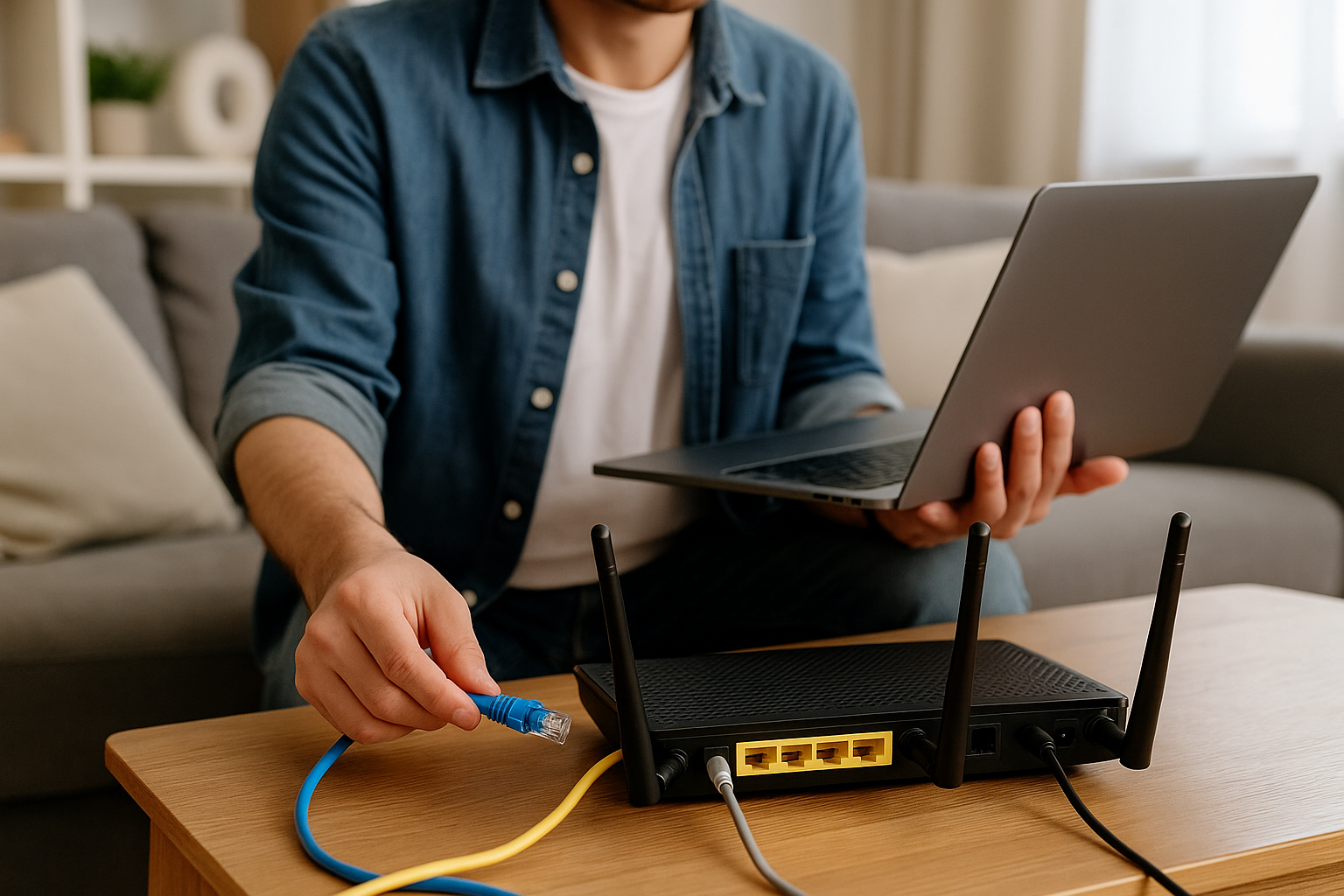Modern homes are filled with connected devices—phones, laptops, TVs, smart speakers, gaming consoles, and more. To keep everything running smoothly, you need a home network that’s stable, fast, and secure.
Whether you’re working from home, gaming online, or just want consistent Wi-Fi in every room, this guide will show you how to set up a reliable home network for multiple devices.
Step 1: Choose the Right Internet Plan
Start by choosing an internet plan that matches your household’s usage.
If you have:
- 1–3 users: 100–300 Mbps may be enough
- 3–6 users: 300–600 Mbps is more comfortable
- 6+ users or heavy usage (4K streaming, gaming, remote work): 600 Mbps to 1 Gbps or more
Fiber-optic connections offer faster and more stable performance, especially for uploads and multiple simultaneous users.
Check if your current plan is meeting your actual speed needs by running speed tests throughout the day.
Step 2: Get a Modern Router
A good router is essential. Outdated models can’t handle dozens of devices or higher-speed connections.
Look for routers with:
- Wi-Fi 6 or Wi-Fi 6E for better speed and efficiency
- Dual-band or tri-band support
- MU-MIMO and OFDMA for handling many devices
- WPA3 security
- Ethernet ports for wired connections
Popular models include the ASUS RT-AX86U, Eero 6+, and Google Nest WiFi Pro.
For very large homes, consider a mesh system instead of a single router.
Step 3: Optimize Router Placement
Your router’s location affects your network’s strength.
Place it:
- Centrally in your home
- Elevated (on a shelf or mounted)
- Away from thick walls, metal objects, and microwaves
- Out in the open—not in a drawer or cabinet
Avoid corners or basements unless you’re using mesh nodes.
Good placement reduces dead zones and boosts overall performance.
Step 4: Use Wired Connections Where Possible
Wi-Fi is convenient, but Ethernet is more stable and faster. Devices that don’t move—like desktops, smart TVs, or gaming consoles—should use Ethernet.
Benefits of wired connections:
- Lower latency
- Higher speeds
- No signal interference
- More secure
Most modern routers offer 4–8 LAN ports. If you need more, add a switch to expand your wired connections.
Step 5: Set Up a Mesh Network (If Needed)
For homes over 2,500 sq ft or those with thick walls or multiple floors, a mesh system is ideal.
Mesh routers use multiple units to provide seamless coverage throughout your home.
They automatically route traffic to the nearest, fastest node—eliminating dead zones.
Top mesh options:
- Eero Pro 6E
- TP-Link Deco X90
- ASUS ZenWiFi
- Netgear Orbi
Easy setup apps let you manage your mesh network with just a few taps.
Step 6: Assign Device Priorities
With many devices online at once, some may compete for bandwidth.
Use your router’s Quality of Service (QoS) settings to prioritize:
- Video calls
- Streaming
- Gaming
- Smart home devices
This ensures lag-free Zoom meetings or 4K video playback, even if someone else is downloading files or playing online games.
Some routers even auto-detect traffic types and optimize them automatically.
Step 7: Create a Guest Network
Separate your main devices from those used by guests or short-term visitors.
A guest network:
- Keeps your devices private
- Prevents accidental network changes
- Reduces security risks from untrusted devices
Name it clearly, set a strong password, and limit bandwidth if needed.
It’s a simple feature that adds a big security boost.
Step 8: Use IP Address Management
Too many devices connecting at once can cause IP conflicts or slowdowns.
Enable DHCP in your router so it assigns unique IP addresses automatically.
For advanced users, consider assigning static IPs to devices like printers, NAS drives, or smart hubs.
This makes network management and troubleshooting easier.
Step 9: Secure Your Network
With more devices online, security is critical.
Follow these practices:
- Use WPA3 encryption (or WPA2 at minimum)
- Change your router’s admin username and password
- Disable remote management if not needed
- Keep firmware updated
- Use a strong Wi-Fi password
- Enable automatic security patches
Secure networks protect your data, devices, and prevent unwanted access.
Step 10: Manage Devices with an App
Modern routers and mesh systems offer mobile apps that let you:
- See all connected devices
- Pause internet for specific users
- Set parental controls
- Monitor speed and performance
- Run diagnostics or reboot remotely
Apps from brands like ASUS, TP-Link, Google, and Eero are user-friendly and powerful.
Keep your network in your pocket for easy management.
Step 11: Extend with Switches and Access Points
If you have many wired devices or areas where mesh is overkill, consider:
- Ethernet switches: Expand wired connections
- Access points: Create wired wireless zones
- Powerline adapters: Use electrical wiring to extend internet
These tools help build a flexible, powerful home network that adapts to your needs.
Step 12: Monitor and Troubleshoot Regularly
Run monthly speed tests and check for:
- Slower-than-usual performance
- Devices failing to connect
- Firmware updates available
- Congested bands (2.4 GHz vs 5 GHz)
If needed, reboot your router or change the Wi-Fi channel to avoid interference from neighbors.
Stay proactive to keep everything running at peak performance.
Final Thoughts: Build a Network That Works for Everyone
A reliable home network is no longer a luxury—it’s a necessity.
With the right router, thoughtful layout, and smart device management, you can enjoy fast, secure, and seamless internet across all your devices.
Whether you’re a remote worker, a gamer, or managing a smart home, this setup gives you the freedom to connect without compromise.

With over two decades of experience in the tech world, the author of Promoção InternetFibra is passionate about helping people improve their home internet. He specializes in networks, equipment, and performance optimization, turning complex tech topics into simple, practical advice. His mission is to make reliable, high-speed internet accessible for everyone.
